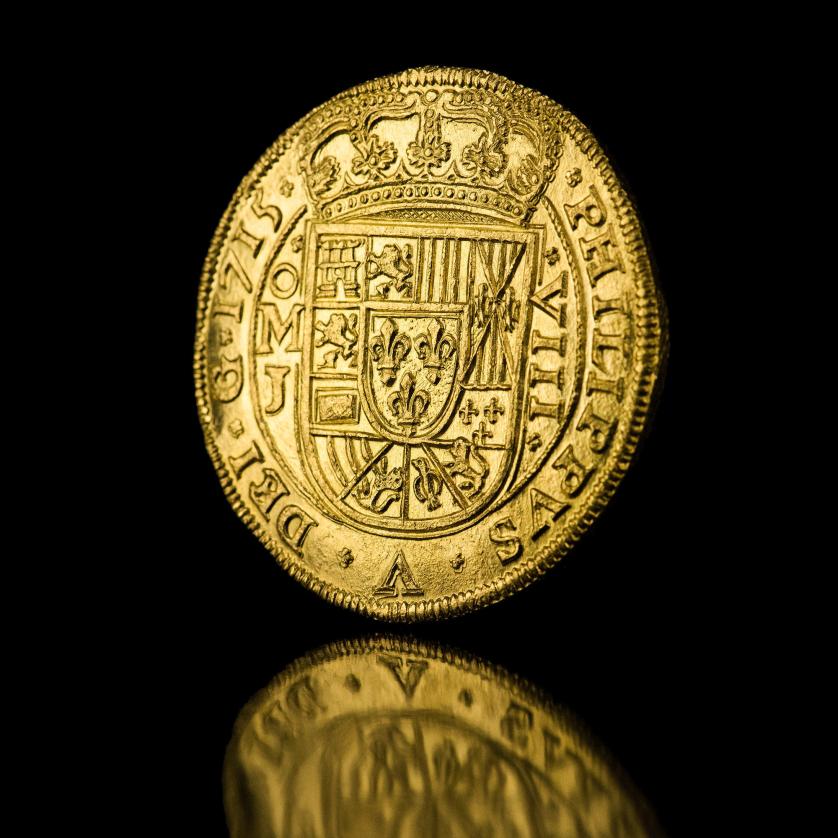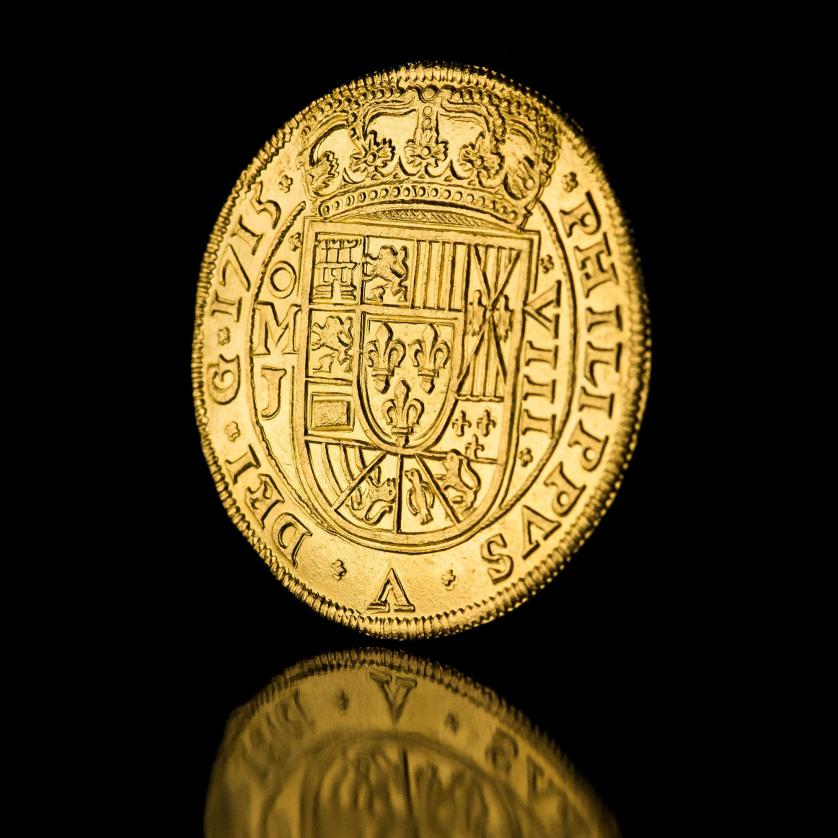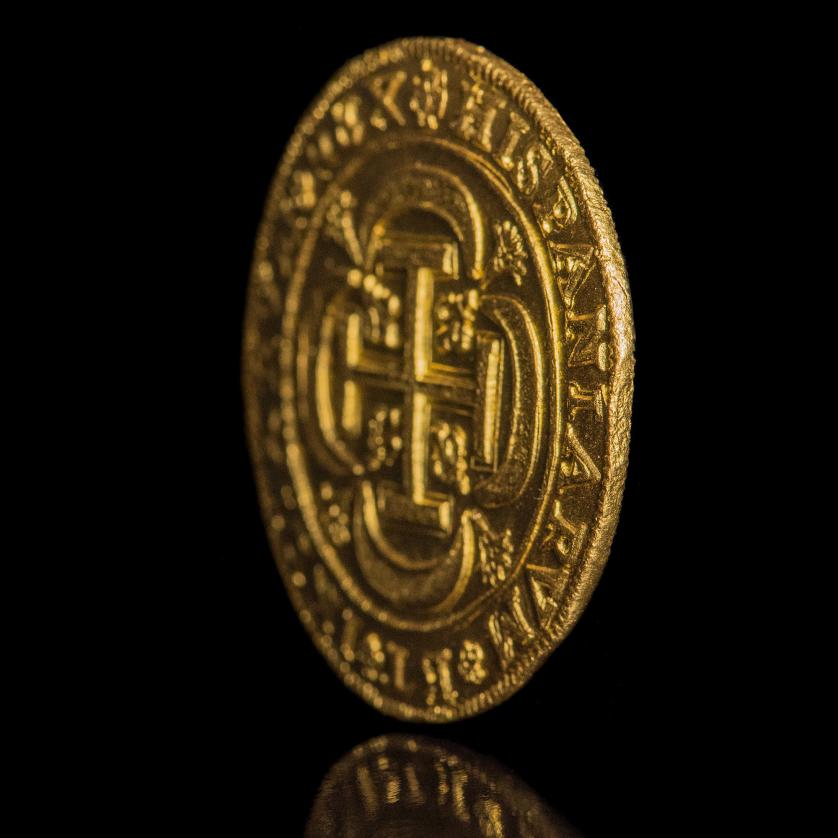Lot 1015
Auction date
27-06-2024 12:30 CET
Finalized
Starting price 250.000 €
SOLD BY 630.000 €
PHILIP V
Philip V. 8 escudos, 1715, Mexico, J, "Royal" type, Large rosettes in the reverse legend. AU 26,94 g. 34,8 mm. AC-2196. Onza-401. Encapsulated by NGC MS 68 Fleet "Top Pop" (2915286-001). Finest known of 8 escudos graded by NGC census. Extremely rare.
Categories
NumismáticaThe pinnacle of Spanish colonial coinage is the Mexican 8 escudos Royal (galano), a large gold coin so beautifully perfect as to be considered among the most desirable gold coins in the world. Exceedingly rare, less than 50 of these 8 escudos Royals are known in only a dozen dates within the 53-year span in which Mexico made gold cobs (1680-1732). Unlike the crude, uneven cobs, Royals (galanos) are perfectly round and evenly struck on planchets of uniform thickness, with obverse and reverse in alignment like medals. Their exact purpose remains unknown, simply listed in Spanish archival records as “galanos” with a higher cost of production, but it is safe to assume they were formal presentation pieces, whether intended for the King himself (hence the 20th-century nickname “Royal”) or for special occasions. Only the mint of Mexico City made these gold galanos. Most of the known examples originate from the Spanish 1715 Fleet sunk off the east coast of Florida in the United States. The so-called 1715 Fleet consisted of eleven ships lost on shallow reefs, not counting a lone survivor, the tag-along French ship Grifon, which continued safely to Europe without knowing the fate of the other ships. The lost Spanish ships were a combination of two regular fleets—the Tierra Firme Fleet coming from Cartagena loaded with Peruvian and Colombian treasures, and the New Spain Fleet coming from Mexico with freshly minted coins and Asian jewels from the Manila Galleon trade—united in Havana for the northeasterly trip back to Spain. These fleets were supposed to be annual but were delayed by the War of Spanish Succession following the death of Charles II in 1700, causing the treasure to pile up for years in Mexico and Colombia. Spain desperately needed this wealth back home and could not wait for the Fleet any longer when it finally left Havana in July, evidently right into the path of a hurricane. The survivors encamped on the shores opposite the wrecks and sent notice to St. Augustine about 175 miles to the north. Some salvage took place, but it was not long before pirates arrived and raided the treasure, both in the camps and in the water. After a few years the tragedy was lost to history, the only later evidence known to us being a notation on a 1774 map by Bernard Romans. This map was rediscovered in 1959 by a local builder named Kip Wagner, who soon located the wrecksites and formed a salvage company to recover the remaining valuables under lease from the State of Florida. This salvage continues today, with major finds being made on eight known sites as recently as 2015, when a trove of ten 8 escudos Royals was recovered. The present coin, dated 1715, has its own story: Residents of Florida’s “Treasure Coast” (so named for the 1715 Fleet) know that not everything comes from the water. On any given day—rain or shine—you will see people combing the beach and hoping to find a piece of the treasure. One of the luckiest of these beach finds was in 1989, when a couple on vacation happened to uncover this coin in the sand after a spring storm. They sold the coin to Florida numismatist Frank Sedwick, and then it was purchased by Fernando Segarra via Jesus Vico and another dealer. In other words, this coin not only has a known pedigree back to its date of manufacture but also demonstrates the long and continuing collaborative friendship between the numismatic firms of Vico and Sedwick. Before being sold, this coin and its story appeared on the cover of the PLVS VLTRA newsletter for the second quarter of 1989, and later became a Plate Coin in the second edition of the Practical Book of Cobs (1990) published by Frank Sedwick, a pioneer in the study of cob coinage. Now graded MS 68 by NGC, this is by far the finest example of a Mexican 8 escudos Royal. In fact, it is the highest grade awarded to ANY 8 escudos from any mint, colonial or Republic. The quality of detail and sharpness of strike, no doubt imparted by some kind of early coining press, combine with extreme luster and utterly pristine preservation to make for the finest onza ever to exist. It is a unique numismatic treasure for the ages. Daniel Frank Sedwick
Recomended lots
Confirm your maximum bid
You are bidding for €
At the time of auction we will contact you by phone:
Confirm your maximum bid
You are bidding for
€
Loading…
Conecting with the server
Are you sure you want to buy the lot?
Confirm your maximum bid
You are bidding for
€
















